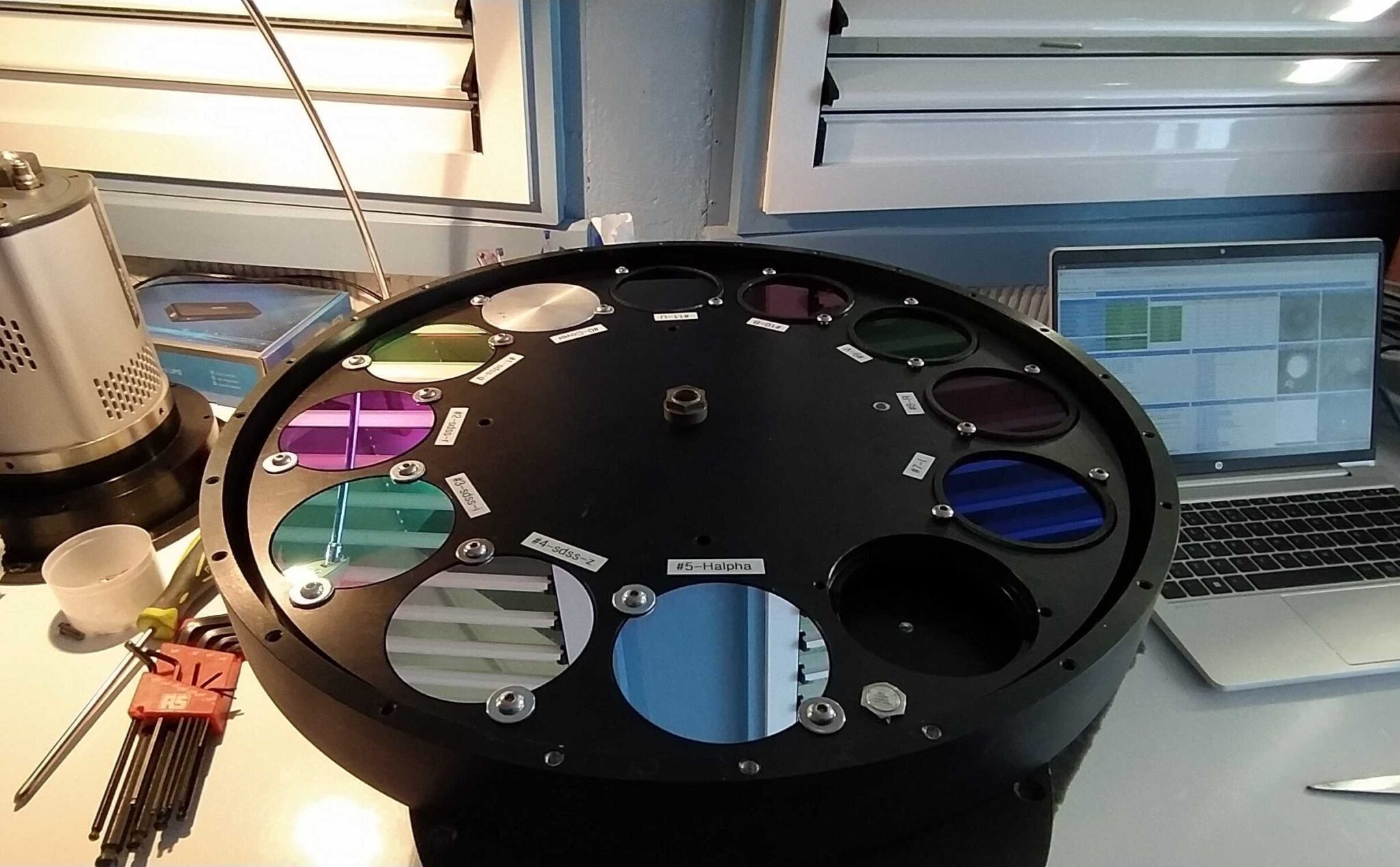New filters for the Joan Oró Telescope of the Montsec Observatory

These filters are used in a wide variety of astronomical topics, including the study of star formation and evolution, supernovae, and binary systems, among others
The telescope has also a new automatic planning system for real-time observations
The Montsec Observatory, an infrastructure managed by the Institute of Spaces Studies of Catalonia (IEEC — Institut d'Estudis Espacials de Catalunya), has installed a new set of filters in the Joan Oró Telescope (TJO) to improve its performance. The TJO is the largest telescope in Catalonia, with a primary mirror of 0.8 metres in diameter and an automatic dome of 6.15 metres.
This telescope carries out a wide range of observations related to different scientific cases, such as the research for exoplanets, the study of variable stars, the tracking of asteroids, among others. Its main advantage is the flexibility of the operating modes, which allows the monitoring of objects for long periods of time, as well as the fast reaction capacity, potentially less than a minute. The TJO is named in honour of the Lleida biochemist Joan Oró i Florensa, one of the most remarkable researchers in studies on the origin of life.
The telescope's main observation instrument is the LAIA camera, which now has a new set of photometric filters. These kinds of filters are used in astronomy as standards that let different colors of light pass through—more specifically, certain ranges of wavelengths.
The new filters meet the standards used in other observatories around the world. Specifically, the installed filters are from the Sloan Digital Sky Survey (SDSS) system. Unlike other filter systems, these cover non-overlapping spectral bands, making it possible to better discriminate colours and more accurately characterise the properties of stars. Its main scientific applications are in the fields of astrophysics related to the study of stellar evolution, such as supernovae, the chemistry of stars or binary systems. The TJO will have the g-r-i-z bands (green, red and two near-infrared bands).
Also, a new H-alpha filter has been incorporated, which selects a very narrow band of the hydrogen emission spectrum, centred on a red colour line that receives this name (Hα). The study of light in this spectral line is closely related to the characterisation of the chromospheric activity of stars, as well as star formation processes and the observation of emission nebulae or HII regions.
All these filters are in addition to those already operational (from the so-called 'Johnson-Cousins' system, which covers ultraviolet to infrared), completing up to 11 possible bands for images obtained with the TJO.

Images of the Orion Nebula, combining the new g-r-i filters (left) or using the H-alpha filter (right).
Credits: IEEC
More progress at the Joan Oró Telescope
In recent weeks, the TJO has released a new automatic planning system for real-time observations. This is an essential part of the TJO's robotic operations, and with the latest improvements it allows user-configured observations to run almost immediately, even at any time of the night.
A good example of this application was the tracking of asteroid 2023 CX1, a few hours after it was discovered and before it impacted the Earth's atmosphere in northern France on the morning of 13 February. The entry into the atmosphere of 2023 CX1 was also captured live by the cameras of the Montsec Observatory.
Improvements in the control of the environment, both through sky surveillance cameras and a large and robust system of meteorological sensors, are another of the significant advances that complement and facilitate the robotic observations of the TJO. The control system of the telescope has redundant information from parameters measured at the OdM, such as wind, clouds, humidity or rain, allowing it to reliably decide when to stop or continue the observations depending on the weather and the state of the sky.
Links
– IEEC
Image
Caption: The new filters already installed on the wheel that is part of the LAIA instrument of the Joan Oró Telescope.
Credit: IEEC
More information
The Institute of Space Studies of Catalonia (IEEC — Institut d’Estudis Espacials de Catalunya) promotes and coordinates space research and technology development in Catalonia for the benefit of society. IEEC fosters collaborations both locally and worldwide and is an efficient agent of knowledge, innovation and technology transfer. As a result of more than 25 years of high-quality research, done in collaboration with major international organisations, IEEC ranks among the best international research centers, focusing on areas such as: astrophysics, cosmology, planetary science, and Earth Observation. IEEC’s engineering division develops instrumentation for ground- and space-based projects, and has extensive experience in working with private or public organisations from the aerospace and other innovation sectors.
IEEC is a private non-profit foundation, governed by a Board of Trustees composed of Generalitat de Catalunya and four other institutions that each have a research unit, which together constitute the core of IEEC R&D activity: the Universitat de Barcelona (UB) with the research unit ICCUB — Institute of Cosmos Sciences; the Universitat Autònoma de Barcelona (UAB) with the research unit CERES — Center of Space Studies and Research; the Universitat Politècnica de Catalunya · BarcelonaTech (UPC) with the research unit CTE — Research Group in Space Sciences and Technologies; the Spanish Research Council (CSIC) with the research unit ICE — Institute of Space Sciences. The IEEC is a CERCA (Centres de Recerca de Catalunya) centre.
Contacts
IEEC Communication Office
Barcelona, Spain
E-mail: comunicacio@ieec.cat
Lead Researcher at IEEC
Kike Herrero
Institute of Space Studies of Catalonia (IEEC)
Montsec Observatory, Sant Esteve de la Sarga, Spain
E-mail: eherrero@ieec.cat
